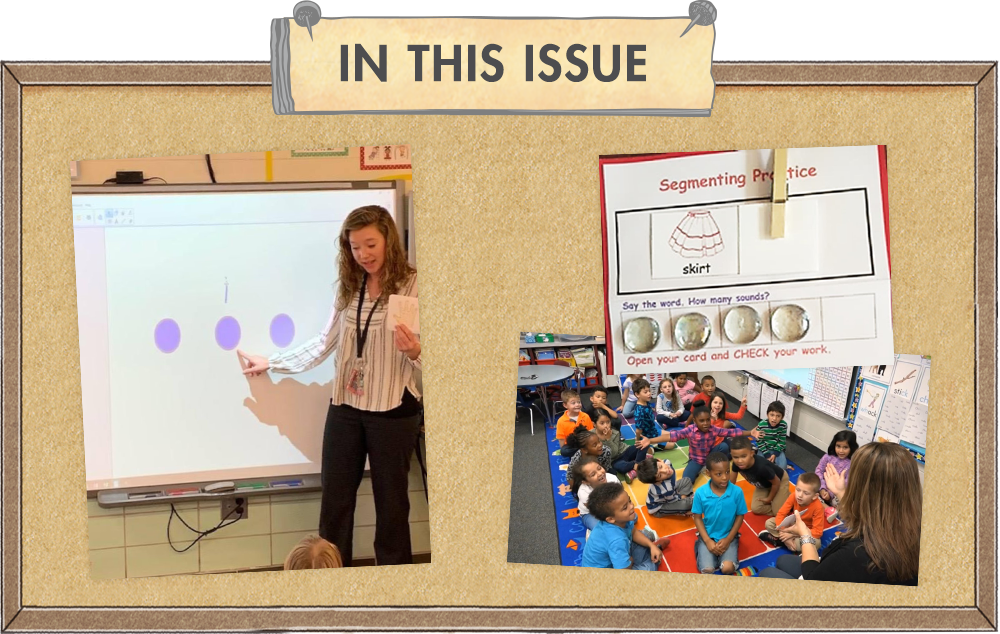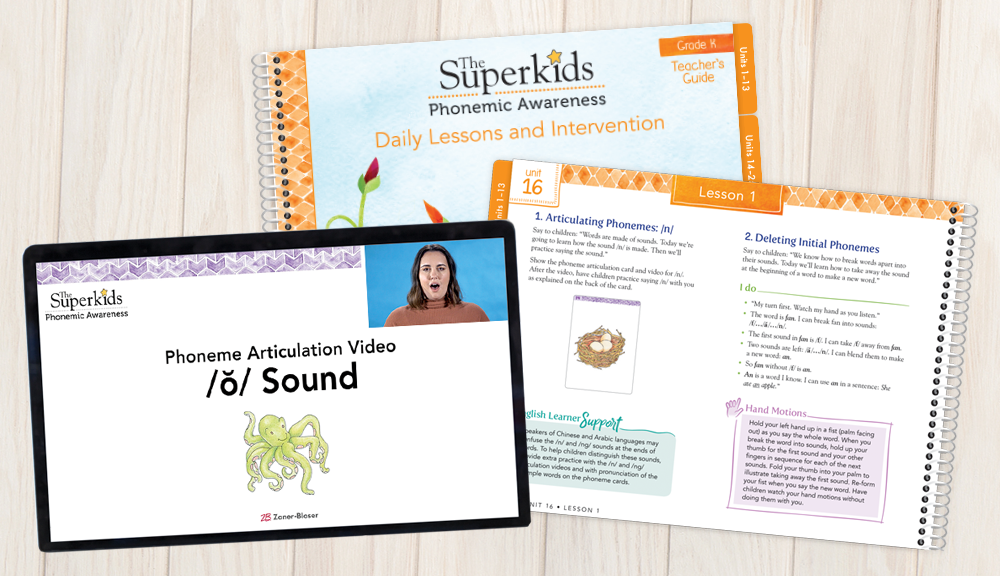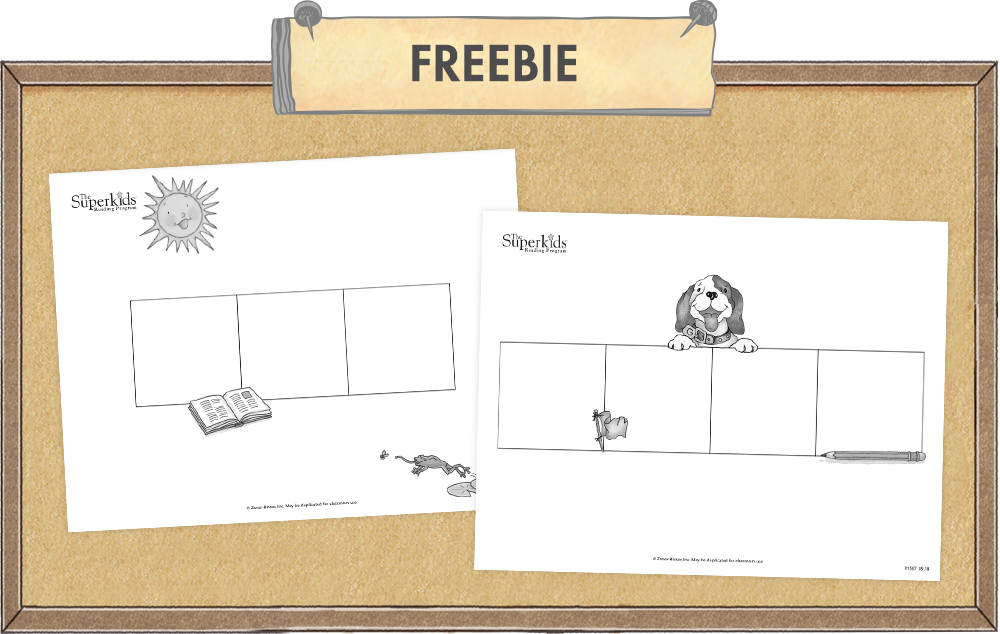|
|
|
|
ISSUE 29 | APRIL 2022
|
|

|
|
|
|
|
|
Careful listening is something children must do daily to succeed in school, whether it involves changing activities at the sound of a bell, following oral directions, participating in classroom discussions, comprehending read-aloud books, playing rhyming games, or spelling words that you dictate. In order to be able to read and spell with success, children must develop phonological and phonemic awareness skills. In this issue, we highlight the importance of building a sensitivity to the sound structure of language. We also share a big announcement about the return of a special summer event!
|
|
|

|
|
|
|
|
|
One key way children develop language skills is by processing sounds in the world around them. First, they acquire auditory discrimination (the ability to hear and distinguish between environmental sounds). Then they develop phonological awareness (the understanding that spoken language is made up of meaningful units of sounds, such as sentences, words, syllables, and rhyming parts). As children study spoken words more closely, they develop phonemic awareness (the understanding that a word is made up of a sequence of small units of sounds, or phonemes). Children need strong phonemic awareness skills to develop the phonics skills necessary for reading and writing.
Phonological awareness is taught and practiced throughout the beginning semester of Superkids kindergarten. Children identify same and different word sequences, distinguish between long and short words, recognize syllables in words, identify words in sentences, recognize rhyme, and segment spoken words into parts. This practice often occurs during the Daily Routines.
To develop phonemic awareness in kindergarten, students practice each new target phoneme within a Superkids song. Children complete phonemic activities in their Student Books and during Daily Routines. In first grade, Superkids teaches the remaining 44 phonemes in the English language, including the sounds of consonant digraphs, long vowels, r-controlled vowels, and other variant vowels. Children learn to distinguish between long- and short-vowel sounds. They practice segmenting sounds in Daily Routines for spelling. Superkids in second grade reviews and gives more practice with all 44 phonemes to ensure children’s mastery.
|
|
|

|
|
|
|
|
|
Phonological and phonemic awareness deficits can lead to difficulty understanding letter-sound correspondences and hamper children’s abilities to read and spell. During your informal observations, note students who struggle with skills related to listening. If you suspect a student is having issues with phonological or phonemic awareness skills, note whether the student has trouble with these tasks:
- Identifying sentences, words, or syllables in oral language activities
- Identifying words that sound alike
- Identifying and producing rhymes
- Identifying the beginning, middle, or ending sounds in words
- Hearing and identifying specific sounds within spoken words
- Oral manipulation of sounds within words (adding, substituting, or removing a sound within a word; blending individual sounds or word parts together; or dividing a word into parts or individual sounds)
If you notice a student or group of students with deficits in one or more of these skills, provide additional support using these resources:
- Building Blocks of Reading, a booklet included with the kindergarten materials, provides activities to use with children who might have deficits in phonological and phonemic awareness.
- Superkids Skill-Building Book contains activities for targeted practice to strengthen skills related to sounds.
- Some Ten-Minute Tuck-Ins focus on reinforcement of phonological or phonemic awareness skills.
|
|

|
|
|
|
|
With modern reading research becoming more readily available to educators, teachers are searching for ways to add more phonological and phonemic awareness instruction. If you are planning to devote additional instructional time to grow these important foundational skills with your students, check out these whole-group lessons for grades K–2 from The Superkids Phonemic Awareness curriculum. Each lesson takes 10–12 minutes, covers two or three skills, and can be done any time during the school day! In this sampler, you will also find intervention activities and information about assessment of phonological and phonemic awareness skills that are included in the curriculum.
The Superkids Phonemic Awareness curriculum includes 180 lessons to build the phonological and phonemic awareness skills students need to become successful readers. The completely oral lessons follow a consistent I Do/We Do/You Do routine, but most importantly—they are FUN! Phoneme Articulation Cards offer students a visual cue for the focus phoneme, and Phoneme Articulation Videos demonstrate and explain to students how to correctly use the tongue, lips, teeth, vocal box, and breath to form sounds. Be sure to check it out!
|
|

|
|
|
|
|
|
Our second annual Superkids Schools Conference will be held June 21, 2022! Join us for this online learning event for K–2 teachers and leaders. Superkids specialists and expert classroom teachers will lead sessions that focus on the most-requested topics, and we have two exciting keynote speakers lined up. The theme of this year’s conference is Engage & Champion. We invite you to participate in conversations about ways we can engage our students with The Superkids Reading Program and champion their academic and emotional growth.
This full day of virtual learning is a wonderful way to connect with Superkids teachers from all over the country. You will also receive extended access to recorded sessions with your ticket.
Register before April 30, 2022, to receive special early bird pricing!
|
|
|
|
|
|
|

|
|
|
|
|
Use these Superkids-themed sound boxes to practice segmenting words into individual phonemes. To use this resource, provide each child with a copy of the Sound Boxes printable and a few counters such as chips, coins, or cubes. Clearly pronounce a target word and ask the child to repeat the word (stretching out the word by sound if needed). The child will move one counter into each cell of the boxes on the printable, from left to right, for each sound they hear. Once finished, run a finger under each sound box to blend the sounds back together.
Tip: The Big Book of Blending and Big Book of Decoding are great places to find target words to use during the current unit.
|
|
|
|
|
|

|
|
|
|
|